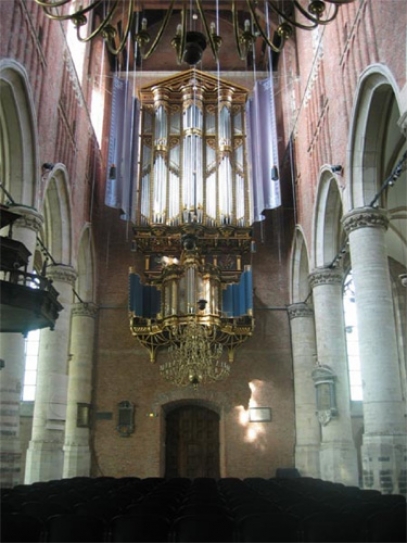


Leiden, Pieterskerk

Galtus Germersz and Germer Galtusz van Hagerbeer 1636 - 1643, RP case of 1625
State of preservation:
Apart from the 17th century pipes founding the instrument's character, the organ contains about a hundred pipes of the oldest layer of c1446 esp in the front. A unique feature of this organ among other big Dutch organs is its temperature with pure thirds contributing significantly to the organ's sound with its large mixtures .
Its last restoration by Verschueren Orgelbouw 1994-98 required but also enabled considerable reconstructions following traces in the instrument including pipes, wind and key actions.
Alreaady in c1446 an organ was built in Pieterskerk by an unknown maker. The instrument had a Hoofdwerk on 16’ and presumably a Bovenwerk on 4’. This organ was enlarged in 1518 by Jan van Covelens, possibly then including a Rugwerk which was replaced by a new one by Jan Jacobsz van Lin in 1625.
This was followed by a new organ by Galtus Germersz and Germer Galtusz van Hagerbeer between 1636 (contract) and 1643. The Hagerbeer family was an organ makers' dynasty immigrated from Eastern Frisia and influenced Dutch organs by great projects in major cities like Leiden, Utrecht, Gouda, s’Hertogenbosch, Alkmaar, Amersfoort, Arnhem or Den Haag.
The present case with wings was made for the Hagerbeer organ except the Rugwerk case by van Lin which was enlarged but kept. The Hagerbeers worked inside the organ and kept parts of older material but none of their immediate predecessor van Lin. Their organ (reconstr. III+P/36) was a 24’ instrument with a lowest pipe giving F' and Hoofdwerk manuals from F'. The part of the pedal keyboard from F to d1 borrowed HW pipes one octave lower.
In 1690 Johannes Duyschot gabe the Rugwerk a darker tone quality by changing the Mixtuur and diapasons 8' and 4'.
From 1774 on further modifications severely influenced the character of the Hagerbeer organ including enlarging the number of stops. The necessary changes in technique harmed the organ fuction further, as well as a "restoration" in 1944-46 trying to achieve a fantasy image of a baroque organ which included deletion of original pipe material, severe damage to remaining old pipes, and new pipes not matching older patterns. So very soon a new restoration was demanded based on thorogh investigation and research of the original starting in the mid 1980s leading to the restoration by Verschueren.
Q: Peter van Dijk: „Het Van Hagerbeer-orgel in de Pieterskerk te Leiden.“ Het orgel 96, Nr. 1 (2000), 18–26.
Musikbeispiel:
Jan Pieterzoon Sweelinck (1562-1621): präludium pedaliter
Gespielt von Peter van Dijk
Disposition
Die heutige Disposition entspricht fast ganz der mutmaßlichen Disposition 1643. Nur das RP-Cornet 5f. und die Vox humana 8’ des Oberwerks waren Zutaten des Jahrhunderts nach den Hagerbeers.
Hoofdwerk (HW), II. Manual
F', G', A'-c3
Bass-/Diskantteilung (B/D) zwischen d0/es0
Prestant 24’ 1643 (2 Pfeifen 1446) B/D; ab c0 2f.
Prestant 12’ 1643 (18 Pfeifen 1446) B/D; ab c0 2f., ab f2 3f.
Bourdon 16’ neu nur D
Octaaf 6’ Chor I: 1446, 1643 ab c1 2f.; Chor II: neu
Mixtuur 4-8f. überwiegend 1446 u. 1643 B/D
Groot Scherp 6-10f. z. T. 1446–18.Jh., sonst neu B/D
Klein Scherp 4-8f. z. T. 1446–18.Jh., sonst neu B/D
Trompet 8’ neu nur D
Rugwerk (Rückpositiv, RP), I. Manual
CDE–c3
Teilung zwischen h0/ c1
Untere Lade
Prestant 8’ ab c0 2f. Chor I: überwiegend 1643, Chor II: 1643/neu
Superoctaaf 2’ ab f1 2f. Chor I: überw. 1518, 1643, Chor II: neu
Quintanus 1½ ’ ab gs2 2f. Chor I: überw. 1643, Chor II: neu
Sifflet 1’ ab c2 2f. D-c 1643, Rest neu
Mixtuur 3-8f. 1518, 1643, 1690 u. neu
Scherp 4-6f. 1518, überwiegend neu (nach 1643)
Schalmei 8’ Kehlen 1518 u. neu, Stiefel 1807,
Köpfe u. Becher überwiegend 18. Jh.
Oberlade
Quintadeen 8’ 1643
Octaaf 4’ ab f1 2f. Chor I: 1518, 1643, 1609, Chor II: neu
Holpyp 4’ 1643 ab c0 als Rohrflöte
Sesquialtera 22/3+1 3/5’ D
Cornet 5f. 3 tiefste Chöre 1744, Rest neu
Bovenwerk (Oberwerk, OW)
CDE–c 3
Teilung zwischen h0/ c1
Prestant 8’ 2f. Chor I: 1643, Chor II: 1643/neu
Holpyp 8’ 1643, 1518 ab B als Rohrflöte
Quintadeen 8’ fast ganz 1643
Octaaf 4’ ab c1 2f. Chor I: überwiegend 1643, Chor II: neu
Superoctaaf 2’ ab c1 2f. Chor I: 1643 u. neu, Chor II: überw. neu
Gemshoorn 2’ 1518, 1643 zylindrisch
Nasard 1½ ’ ab c2 2f. Chor I: überwiegend 1643, Chor II: neu
Sifflet 1’ ab c2 2f. neu
Tertiaan überwiegend neu (4 Pfeifen 1643) CD-h1 4/5’; ab c2 13/5’
Sesquialtera 22/3’+13/5’ D
Trompet 8’ neu
Vox humana 8’ 1690
Pedal (P)
CDE–d’
FGA–d’ sind angehängt an F1G1A1–d des Hauptwerks
Octaaf 8’ 1446 u. 1643
Octaaf 4’ 1446 u. 1643
Trompet 16’ 16 Kehlen aus dem 17. Jh., sonst neu
Trompet 8’ neu
Tremulant RP
Tremulant OW
Calcant
Sechs neue Spanbälge
Winddruck: 76 mm WS
Koppeln: 1643 waren keine Koppeln vorhanden. 1690 und heute: B/D HW/RP
Stimmtonhöhe: a’ = 415 Hz, mitteltönige Temperierung
© Greifenberger Institut für Musikinstrumentenkunde | info@greifenberger-institut.de



